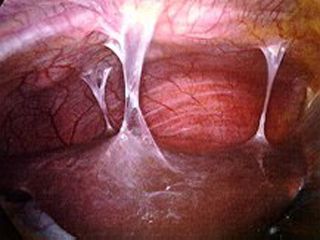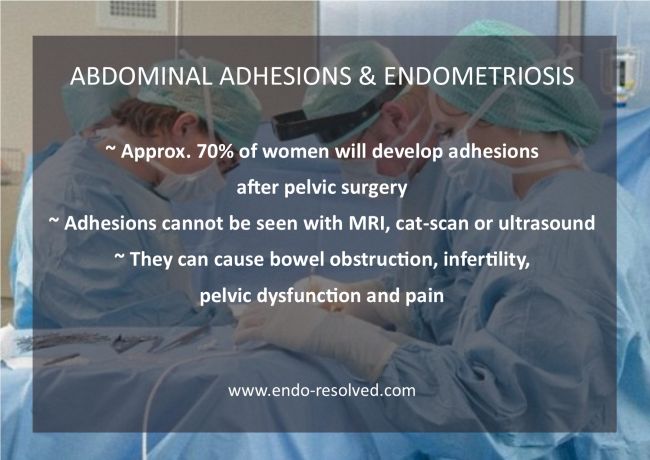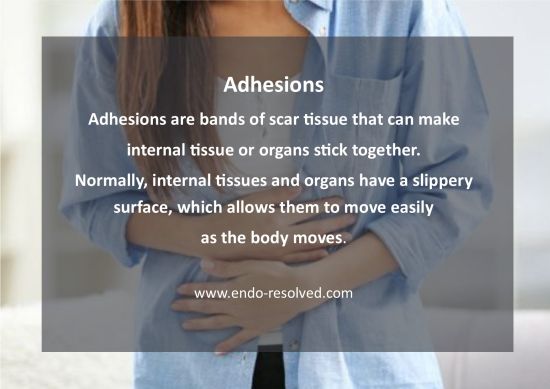Endometriosis adhesions
It is very common for abdominal adhesions to form in women who suffer from endometriosis. This can happen either when two deposits of endometriosis touch in the abdomen and become fused and cause adhesions. They can also form because of scar tissue following surgery for endometriosis.
What are adhesions?
Adhesions are scar tissue resulting from infection, inflammation, trauma, or surgery occurring anywhere in the body.
They are tiny but very strong collagen fibres that form naturally as the first step in healing. In fact, they can form anywhere in the body that healing occurs.
What causes adhesions?
There are six common causes of adhesion formation:
- Infection
- Inflammation
- Surgery
- Trauma
- Radiation therapy
- Chronic poor posture
What does pain caused by adhesions feel like?
Most women will notice the pull of adhesions as tightness, decreased range of motion, or pulls in specific areas of the abdomen. Initially this may be accompanied by a dull pain or ache in these areas that continues or increases over time.
Adhesions create problems in the body when they:
- Put pressure on pain-sensitive tissues or other structures
- Pull on nerves causing pain
- Glue structures that should be mobile, causing dysfunction such as poor digestion, or even infertility
- When nerves or pain-sensitive structures become bound by adhesions, the result is pain.
- Dysfunction occurs when adhered organs and muscles become inefficient, ineffective, or unable to properly do the job for which they were designed.
The obvious problem for women with endometriosis is the need to have surgery to treat the disease and remove endo deposits and implants, but the actual surgery itself can cause more adhesions. A no-win situation.
Fortunately surgical techniques are improving to reduce the development of more adhesions being caused by any initial surgery.
How are adhesions treated?
The usual medical solution to post-surgical adhesions is to first give drug treatment to decrease inflammation, ease the pain, or improve function. If drugs fail to adequately address the symptoms caused by adhesions the physician may suggest a “second look” surgery to help determine the exact cause of the pain.
If the surgeon finds more adhesions, he or she would generally cut or burn the ones which are accessible. However, due to the invasiveness of yet another surgery, additional adhesions generally form following the surgery.
Clinical studies have shown that adhesions occur in roughly 90% of patients after abdominal surgery. These studies show that surgery can develop into small-bowel obstruction, infertility, chronic abdominal and pelvic pain, and difficult re-operative surgery are the most common consequences of adhesions.
Despite the skill of the surgeon, it is very difficult to perform surgery without creating more adhesions. So this becomes a vicious circle. Therefore, when women with endometriosis have continued surgeries to remove endometriosis, they are at increased risk of developing yet further scarring and adhesions.
As mentioned above, new surgical techniques are being developed to reduce adhesions. Read more here
Adhesions and infertility
Adhesions are like a powerful glue, wherever they form. When they form within the delicate female reproductive structures, they can glue down structures, reducing their ability to function. Adhesions are a major cause of female infertility, and implicated as a cause of many cases of unexplained fertility issues.
Alternative treatment for adhesions
New alternatives to surgery has been developed called Manual Physical Therapy. One such organisation is Clear Passage Therapy – who have, over 20 years developed their own form of manual physical therapy called the 'Wurn Technique' – named after the doctor who originally developed the technique.
The organisation has undertaken extensive research and had achieved excellent results for many patients, including many women who have undergone therapy for adhesions related to endometriosis.
They can be found at their website at: http://www.clearpassage.com
Dietary help
Proteolytic enzymes - (or proteases) – and the relationship to scar tissue
The most important thing that systemic proteolytic enzymes do is to break down excess fibrin in your circulatory system and in other connective tissue. These enzymes bring nutrients and oxygen-rich blood that remove the metabolic waste produced by inflammation and excess fibrin.
What is fibrin?
Fibrin is produced in the body as a chemical product to help stop bleeding and is used in part of the healing process following injury or surgery.
It has a useful purpose initially in the role of healing, however if the area in question is slow to heal, an excess of fibrin will appear as clumps of scar tissue in the site of the wound, injury or at the surgical site. Once this happens, an acute condition becomes chronic.
For women with endometriosis this action can cause a severe excess of fibrin in the body caused by bleeding implants, scar tissue and post-operative scarring as well.
Dietary supplements to reduce fibrin:
Dietary supplements of proteolytic enzymes can help to break down and reduce fibrin. The supplement of serrapapetase has had success for many with endometriosis to help with pain and inflammation.
Serrapeptase digests non-living tissue, blood clots, cysts, arterial plaque and inflammation in the body. You can read more details about serrapeptase with reviews from those who have had success using this supplement for endometriosis HERE
Reference:
https://endometriosis.org/endometriosis/adhesions/
https://endometriosisnews.com/endometriosis-and-adhesions/
https://www.ncbi.nlm.nih.gov/pubmed/19573306
https://www.drseckin.com/pelvic-adhesion-surgery








